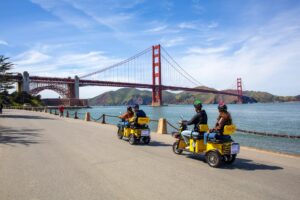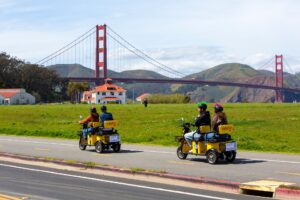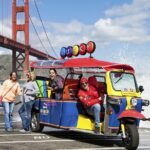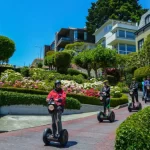Exploring the History and Charm of the San Francisco Ferry Building and Embarcadero
If you’re planning a trip to San Francisco, there’s one iconic landmark you absolutely shouldn’t miss – the historic San Francisco Ferry Building and the bustling Embarcadero waterfront. This charming area has a rich history, and stunning architecture, and offers a variety of experiences for visitors. In this article, we’ll take you on a journey through the past and present of the Ferry Building and Embarcadero, including the top seven reasons why you should make it a must-visit destination during your stay in the city by the bay.
The Ferry Building: An Architectural Gem
Location: One Ferry Building, Embarcadero Street
The San Francisco Ferry Building, standing proudly at the foot of Market Street on the Embarcadero, is a true architectural marvel. Designed in 1892 by the American architect A. Page Brown in the Beaux-Arts style, it was completed in 1898. At the time, it was the largest project in the city and remains a symbol of San Francisco’s history as a bustling port city.
The Towering Clock
One of the most recognizable features of the Ferry Building is its 245-foot-tall clock tower. With four massive clock dials, each 22 feet in diameter, it’s a prominent fixture in the city’s skyline. The clock tower draws inspiration from the Giralda bell tower in Seville, Spain, adding a touch of European charm to San Francisco’s waterfront.
Historic Resilience
The Ferry Building has weathered the test of time, surviving both the 1906 and 1989 earthquakes with minimal damage, thanks to its robust construction. This building has served as a vital connection for commuters traveling to San Francisco from the East Bay, as well as for transcontinental rail lines.
The Transformation
As the years passed and transportation methods evolved, the Ferry Building adapted to changing needs. By the 1950s, it saw decreased use due to the construction of bridges and the conversion of streetcar routes to buses. The building was repurposed for office use, and its public spaces underwent significant changes, leaving behind some of its grandeur.
The Rebirth and Restoration
In 2002, a remarkable restoration and renovation project breathed new life into the Ferry Building. The 660-foot-long Great Nave, with its lofty ceilings, was lovingly restored to its former glory. The ground floor was transformed into a vibrant marketplace, creating a luxurious open-market atmosphere.
The Ferry Building Today
Fast forward to today, and the Ferry Building stands as a testament to preservation, adaptive reuse, and community.
Here are seven compelling reasons to visit this iconic landmark:
1. Farmers Market Delights
Held three days a week, the Ferry Plaza Farmer’s Market is a food lover’s paradise. You can find it in front of the building on Tuesdays and Thursdays, and both in front and behind the building on Saturdays to accommodate the larger crowd. Fresh produce, meat, eggs, and locally sourced items await, along with live jazz music and cooking demonstrations. Don’t forget your reusable bag and some cash to savor the local flavors.
2. Culinary Adventures
The ground floor of the Ferry Building is home to around 50 restaurants, retail shops, and food purveyors. From artisanal cheeses to gourmet chocolates, you’ll find a wide array of culinary delights to satisfy your palate.
3. Iconic Clock Tower Views
Take a moment to admire the city from the towering clock tower. The breathtaking views of San Francisco and the bay are worth the visit alone. It’s also a fantastic spot for photos and capturing the city’s beauty.
4. Historic Streetcars
Explore San Francisco’s charm by hopping on the historic streetcars that stop at the Ferry Building. The E Embarcadero and F Market & Wharves lines offer a nostalgic ride through the city’s streets.
5. Waterfront Strolls
The Embarcadero waterfront has undergone a stunning transformation. You can now enjoy spacious sidewalks, historic streetcars, and easy access to Fisherman’s Wharf, Oracle Park, the Financial District, and BART transit.
6. Connection to San Francisco’s History
By visiting the Ferry Building, you’re stepping into the pages of San Francisco’s history. From its role as a major transit terminal to its adaptive reuse as a hub of local culture, it’s a place that bridges the past and present.
7. Community and Sustainability
The Ferry Building’s ground floor is a haven for local, sustainable products. By supporting the vendors here, you’re contributing to the preservation of San Francisco’s unique culture and ensuring its sustainable future.
The San Francisco Ferry Building and Embarcadero offer a fascinating journey through the city’s history and culture. From its architectural splendor to its vibrant marketplace, this iconic landmark is a must-visit destination for anyone exploring San Francisco. Whether you’re a history enthusiast, a foodie, or simply looking for a picturesque spot to enjoy the city’s charm, the Ferry Building has something special to offer. So, make sure to add it to your itinerary and savor the flavors and stories of San Francisco’s past and present.
Unveiling the Vibrant History of San Francisco’s Embarcadero
San Francisco’s Embarcadero is more than just a waterfront roadway; it’s a place where history, culture, and urban development converge. This iconic stretch of land along the city’s eastern waterfront has seen remarkable transformations over the years. In this article, we’ll delve into the rich history of the Embarcadero and uncover six fun facts that make it a captivating destination for both locals and visitors.
The Birth of Embarcadero
The name “Embarcadero” derives from the Spanish verb “embarcar,” meaning “to embark.” It aptly signifies its role as the place to embark on journeys, reflecting its historical significance as a bustling seaport. The Embarcadero is a three-mile-long engineered seawall that stretches along San Francisco’s eastern waterfront, adorned with piers extending into the bay.
A Thriving Seaport
In the early 1900s, the Embarcadero was a hub of maritime activity. It served as a bustling seaport where ships from around the world arrived with goods, bringing life and commerce to the city. The waterfront was a hive of activity, with ships unloading cargo and passengers setting foot on San Francisco’s shores.
World War II Military Hub
During World War II, the Embarcadero took on a new role as a crucial military hub. The port played a pivotal role in supporting the war effort, with troops and supplies passing through its piers. It was a time when the Embarcadero played a vital role in defending the nation.
The Rise and Fall of the Embarcadero Freeway
In the 1960s, the Embarcadero landscape underwent a significant change with the construction of the Embarcadero Freeway. This elevated highway dominated the area for three decades. However, its presence was short-lived. The devastating 1989 Loma Prieta earthquake caused substantial damage to the freeway, leading to its eventual demolition in 1991.
A Remarkable Urban Renaissance
The removal of the Embarcadero Freeway marked a turning point in the area’s history. It paved the way for a grand redevelopment effort that revitalized the waterfront. The National Trust for Historic Preservation recognized this transformation as a “remarkable urban waterfront renaissance.” Today, the Embarcadero Historic District serves as a thriving economic engine for the entire Bay Area.
Fun Facts About the Embarcadero
Now that we’ve explored the historical backdrop of the Embarcadero, let’s dive into some fascinating fun facts about this vibrant destination:
- Embarcadero’s Reclaimed Land: The Embarcadero was constructed on reclaimed land, a testament to human engineering, creating a space for commerce and culture.
- Historic Streetcars: The Embarcadero boasts a historic streetcar line, including the N Judah, T Third Street, and F Market & Wharves lines, offering a charming and nostalgic way to explore the city.
- Easy Access: The Embarcadero provides convenient access to some of San Francisco’s most famous destinations, including Fisherman’s Wharf, the Financial District, Oracle Park (home of the SF Giants), Market Street, and BART transit.
- Palm-Lined Beauty: After the freeway’s removal, the Embarcadero underwent a stunning transformation, featuring grand palm-lined boulevards and beautifully restored squares and plazas.
- The ‘E’ Line Revival: The historic ‘E’ line, which historically connected Fisherman’s Wharf to the Caltrain Depot, has been revived. It now operates on weekends between Jefferson and Jones near Fisherman’s Wharf and Fourth and King Streets near the Caltrain terminus.
- A Culinary Delight: While exploring the Embarcadero, don’t miss the chance to savor local culinary delights. Restaurants and food vendors offer a diverse range of delectable options for every palate.
The Embarcadero is a living testament to the evolution of San Francisco, from its maritime roots to its thriving urban renaissance. It’s a place where history meets modernity, making it a must-visit destination for anyone seeking to experience the heart and soul of this iconic city by the bay.







